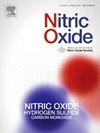寻找转硝基酶
IF 3.2
2区 生物学
Q2 BIOCHEMISTRY & MOLECULAR BIOLOGY
引用次数: 0
摘要
抗氧化剂和促氧化剂之间的生化相互作用维持着细胞的氧化还原平衡,当这种平衡受到中度或高度干扰时,就会导致糖尿病、癌症和神经退行性疾病等慢性疾病的发生和/或恶化。硫氧还原酶、谷胱甘肽和硫辛酸类硫醇氧化还原酶系统构成了强大的细胞抗氧化防御系统的独特组合,因为它们作为 S-亚硝基酶、S-脱谷胱甘肽酶和二硫还原剂,在维持具有生物学意义的还原游离硫醇状态方面发挥着不可或缺的作用。因此,在细胞受到亚硝基胁迫时,细胞抗氧化剂会对其同源的 S-亚硝基蛋白底物进行 S-亚硝基化,而不是通过蛋白质与蛋白质之间的相互作用参与反式 S-亚硝基化。研究人员一直站在最前沿,通过缺乏适当生化逻辑的体外研究实验证据,模糊地确立了 "反式亚硝基化 "的概念及其对病理生理学的影响。科学文献中将抗氧化剂作为反式亚硝基化酶的暗示性和重复性使用给我们留下了几个悬而未决的问题,促使我们 "追寻 "反式-S-亚硝基化学背后的科学逻辑。考虑到情况的严重性,并从 "反式-S-亚硝基化 "的大局出发,我们旨在提出一种新的尝试,以证明人们在接受抗氧化剂能够反式亚硝基化其同源蛋白伙伴时的犹豫不决,并反思解决争议的必要性。要确定 Trx、Grx 或 DJ-1 等抗氧化剂可作为细胞转亚硝基酶的调控机制或条件,还需要进一步的特征描述。本文章由计算机程序翻译,如有差异,请以英文原文为准。
The hunt for transnitrosylase
The biochemical interplay between antioxidants and pro-oxidants maintains the redox homeostatic balance of the cell, which, when perturbed to moderate or high extents, has been implicated in the onset and/or progression of chronic diseases such as diabetes mellitus, cancer, and neurodegenerative diseases. Thioredoxin, glutaredoxin, and lipoic acid-like thiol oxidoreductase systems constitute a unique ensemble of robust cellular antioxidant defenses, owing to their indispensable roles as S-denitrosylases, S-deglutathionylases, and disulfide reductants in maintaining a reduced free thiol state with biological relevance. Thus, in cells subjected to nitrosative stress, cellular antioxidants will S-denitrosylate their cognate S-nitrosoprotein substrates, rather than participate in trans-S-nitrosylation via protein-protein interactions. Researchers have been at the forefront of vaguely establishing the concept of ‘transnitrosylation’ and its influence on pathophysiology with experimental evidence from in vitro studies that lack proper biochemical logic. The suggestive and reiterative use of antioxidants as transnitrosylases in the scientific literature leaves us on a cliffhanger with several open-ended questions that prompted us to ‘hunt’ for scientific logic behind the trans-S-nitrosylation chemistry. Given the gravity of the situation and to look at the bigger picture of ‘trans-S-nitrosylation’, we aim to present a novel attempt at justifying the hesitance in accepting antioxidants as capable of transnitrosylating their cognate protein partners and reflecting on the need to resolve the controversy that would be crucial from the perspective of understanding therapeutic outcomes involving such cellular antioxidants in disease pathogenesis. Further characterization is required to identify the regulatory mechanisms or conditions where an antioxidant like Trx, Grx, or DJ-1 can act as a cellular transnitrosylase.
求助全文
通过发布文献求助,成功后即可免费获取论文全文。
去求助
来源期刊

Nitric oxide : biology and chemistry
生物-生化与分子生物学
CiteScore
7.50
自引率
7.70%
发文量
74
审稿时长
52 days
期刊介绍:
Nitric Oxide includes original research, methodology papers and reviews relating to nitric oxide and other gasotransmitters such as hydrogen sulfide and carbon monoxide. Special emphasis is placed on the biological chemistry, physiology, pharmacology, enzymology and pathological significance of these molecules in human health and disease. The journal also accepts manuscripts relating to plant and microbial studies involving these molecules.
 求助内容:
求助内容: 应助结果提醒方式:
应助结果提醒方式:


